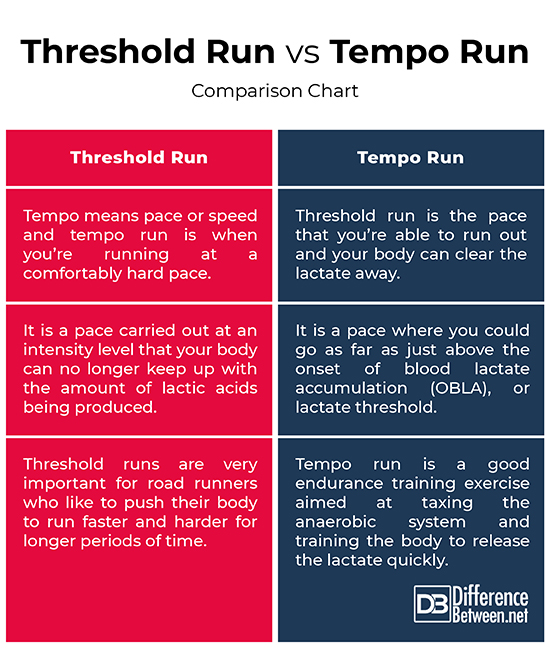Difference Between Threshold and Tempo Run
For those who wish to step up their game, a well-structured and systematic plan is necessary to complete the marathon in a set time. A training plan gives you an idea of the training stress, although it’s not the only contributing factor. The plan comprises of several types of training runs, each with its own set of goals that will test the body and the mind in unique ways. If you wish to take a systematic approach to your training, the first step is to understand the different types of run and what they are aimed at developing. Tempo runs have long been an ideal way to increase your lactate threshold and a staple of all good endurance training plans. Then there’s threshold running, which is a pretty challenging pace, faster than your normal easy run. Let’s take a look at the two.

What is a Threshold Run?
Threshold run is a pace that is faster than your normal easy run, which is something you need to focus on if you really want to get faster. If you’re looking to speed up your time and wish to go that next level, threshold running should be an important component of your training. So what exactly is threshold? Typically, a threshold run, also known as lactate threshold or anaerobic threshold, is a run carried out at an intensity level that your body can no longer keep up with the amount of lactic acids being produced. This anaerobic threshold sits somewhere between your 10k race effort and your half marathon race effort. So, in order to develop that threshold you need to train at that. One classic activity you can do to achieve that anaerobic threshold is what’s called the tempo run.

What is a Tempo Run?
Tempo runs are sustained, comfortably hard runs at a steady pace for 5-10 km. It’s a really important part of your longer distance running training but people often use it interchangeably with terms like threshold run and race pace run. Tempo runs are a year-round staple of all good endurance training plans aimed at taxing the anaerobic system and training the body to release the lactate quickly. Defined as a medium-hard effort over 20 minutes or so (3 to 4 miles), they are an ideal training program to increase your lactate threshold. Livingstone’s contention is that tempo runs are extremely difficult on the body and that runners are better off running “sub-threshold” runs rather than tempo runs. Tempo, literally means pace or speed, and tempo run is when you’re running at a comfortably hard pace. It is not a sprint, but it’s the time pace where you could go as far as just above the onset of blood lactate accumulation (OBLA), or lactate threshold.
Difference between Threshold and Tempo Run
Terminology
– Terms like threshold running or tempo runs are often used interchangeably which creates a bit of confusion as to what they all mean. Tempo runs refer to a pace at an effort level where in your body is able to release as much lactate as it produces. Tempo means pace or speed and tempo run is when you’re running at a comfortably hard pace. Threshold refers to your lactate and threshold run is the pace that you’re able to run out and your body can clear the lactate away.
Intensity
– Threshold, also known as lactate threshold or anaerobic threshold is a pace carried out at an intensity level that your body can no longer keep up with the amount of lactic acids being produced. This anaerobic threshold sits somewhere between your 10k race and half marathon race effort. For most runners, this pace will be 80 to 90 percent of their maximal heart rate or 75 to 85 percent of the heart rate reserve. Tempo run is a classic activity to achieve that anaerobic threshold. Tempo runs are sustained, comfortably hard runs at a steady pace for 5-10 km.
Objective
– Threshold runs are very important for road runners, especially half marathon and marathon runners who like to push their body to run faster and harder for longer periods of time. Threshold run is a pace that is faster than your normal easy run, which is something you need to focus on if you really want to get faster. They are a great way to gain aerobic fitness. Tempo runs are a year-round staple of all good endurance training plans aimed at taxing the anaerobic system and training the body to release the lactate quickly. It gives you a very good idea of what your body can and cannot handle.
Threshold Run vs. Tempo Run: Comparison Chart

Summary of Threshold Run vs. Tempo Run
Tempo runs improve endurance in the same way easy and long runs do. More specifically, tempo runs improve race-specific endurance meaning they are faster and harder than easy runs, but they are well under anaerobic threshold limit, and hence provide much of the same adaptations. Tempo runs are primarily aimed at taxing the anaerobic system and training the body to clear lactate quickly. Tempo runs are an ideal way to increase your lactate threshold – the intensity level at which your body can no longer keep up with the amount of lactic acids being produced.
- Difference Between Serif and Sans Serif - April 22, 2024
- Difference Between HTML and Text - April 19, 2024
- Difference Between FTP and SFTP - April 16, 2024
Search DifferenceBetween.net :
 Email This Post
: If you like this article or our site. Please spread the word. Share it with your friends/family.
Email This Post
: If you like this article or our site. Please spread the word. Share it with your friends/family.
2 Comments
Leave a Response
References :
[0]Humphrey, Luke. Hansons Half-Marathon Method: Run Your Best Half-Marathon the Hansons Way. Colorado, United States: VeloPress, 2014. Print
[1]Dr. Tan, Ben. Run For Your Life!: The Complete Marathon Guide. Singapore, Southeast Asia: Marshall Cevendish, 2010. Print
[2]Pfitzinger, Pete and Philip Latter. Faster Road Racing: 5K to Half Marathon. Illinois, United States: Human Kinetics, 2014. Print
[3]Image credit: https://media.defense.gov/2013/Dec/24/2000886484/-1/-1/0/131121-F-XG484-104.JPG
[4]Image credit: https://media.defense.gov/2015/Dec/21/2001331291/-1/-1/0/151216-F-NQ441-062.JPG


You have your chart messed up. Tempo and threshold are switched on the top indicator.
terrible explanation. Really confusing